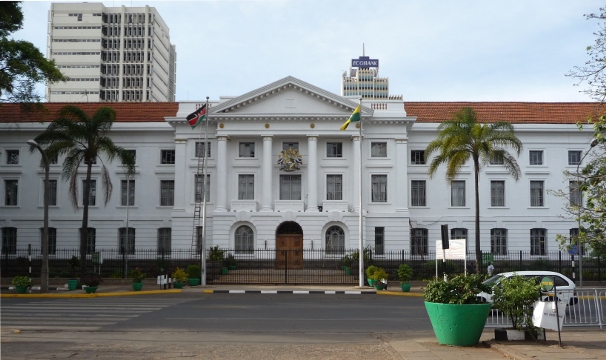Nairobi City Council on:
[Wikipedia]
[Google]
[Amazon]
The City Council of Nairobi was the local authority governing the city of 

Nairobi
Nairobi ( ) is the capital and largest city of Kenya. The name is derived from the Maasai phrase ''Enkare Nairobi'', which translates to "place of cool waters", a reference to the Nairobi River which flows through the city. The city proper ha ...
, Kenya
)
, national_anthem = "Ee Mungu Nguvu Yetu"()
, image_map =
, map_caption =
, image_map2 =
, capital = Nairobi
, coordinates =
, largest_city = Nairobi
, ...
. It was the largest of the 175 local Authorities in the country and was under direction of the Ministry of Local Government.
The chief executive of the city council was the town clerk and was appointed by the Minister of Local Government. The non-executive branch of the council was headed by the mayor. The town clerk oversaw the functions of 17 main and 4 sub committees whose members were city councillors. Each committee is chaired by one councillor. The committees meet at scheduled meetings and adopt proposals by consensus. The proposals then pass through a full council for review. Proposals could only be approved as council resolutions by the Minister for Local Government having been reviewed by the full council.
The main offices of the Nairobi City Council were located at City Hall Plaza on City Hall Way. City Hall was constructed in the 1950s. At that time it was the tallest building in Nairobi, with its clock tower standing at 165 ft high. The building was expanded in 1981 with the addition of the 13-storey City Hall Annex.

History
In 1963 after Kenya achieved independence, the Nairobi Urban District Council, NUDC or simply UDC, became the City Council of Nairobi (CCN).2 The Council was created by an act of Parliament, Cap 265 of the Laws of Kenya to provide services to residents of the city. Among other functions, the City Council was responsible for the provision of essential services like water, sewer and public safety.Structure and organization
The Executive branch of the city was headed by the town clerk. He oversaw the functions of the following: 1. Director - Public Health Department 2. Director - City Inspectorate Department 3. Director- Environment Department 4. Director Environment Department 5. Assistant Director - Town Clerk’s Department 6. City Treasurer- City Treasury Department 7. City Engineer – City Engineer’s Department 8. Director- Education Department 9. Director -City Planning Department 10. Director -Housing Development Department 11. Director -Human Resource Department 12. Director – Procurement 13. Director -Legal Services 14. Director Investigations and Information Analysis—General Manager – Nairobi Water and Sewerage Company. The policy formulation branch of the city was headed by the Mayor who oversaw the functions of the following committees. 1. General Purposes Committee 2. Education Committee 3. Social Services committee 4. Staff Committee 5. Public Health Committee 6. Water and Sewerage Committee 7. Internal Committee 8. Environment Committee 9. Works Committee 10. Inspectorate Committee 11. Town Planning Committee 12. Housing Development Committee 13. Joint Workers Committee 14. Joint Staff Committee 15. Finance Committee 16. Tender Committee 17. LASDAP Committee.3 Sub-committees of the Council: Rental Housing Sub-committee Property and Assets Sub-committee Works Sub-Committee Licensing Sub-Committee Street Naming Sub-CommitteeElections and representation
The city is divided into 8 divisions which also serve as Parliamentary Constituencies. Fifty-five city councillors were elected to represent wards in the 8 divisions. The councillors were elected by registered voters to serve five-year terms, after which they would seek re-election. After the elections, the party with the majority of councillors got to nominate 12 councillors, while the minority party nominates 8 councillors.4 The mayor and deputy mayor were elected by the councillors to serve a two-year term, after which they could also seek reelection.Council divisions and wards
Corruption and problems facing the city
The City Council of Nairobi was responsible for providing services such as housing, healthcare facilities, primary education, emergency response, waste collection, water and sanitation among other services. Most residents however, feel that the city’s ability to provide services was deteriorating and the local government was not effective enough in reducing corruption and poverty. Some vices related to corruption included: *Informal settlements mostly slums and illegal structures mushrooming in the city. *“Land grabbing
Land grabbing is the contentious issue of large-scale land acquisitions: the buying or leasing of large pieces of land by domestic and transnational companies, governments, and individuals.
While used broadly throughout history, land grabbing as ...
”
*Water shortages in the city due to inadequate supplies.
*Uncontrolled dumping of waste.
*“Ghost employees” - non existing employees whose names appear on the city’s payroll and receive pay regardless.
*Street Urchins
*Influx of Street Hawkers
*Bogus names Gazetted as elected Councillors.5
*Shameful fights and brawls by Councillors at Council meetings
A history of corruption scandals has faced almost all the Nairobi City Council Mayors. Scandals ranging from illegal land sale/grabbing to funds misuse.
See also
* Timeline of NairobiReferences
1. http://www.unep.org/dewa/africa/docs/en/NCEO_Report_FF_New_Text.pdf 2.http://www.environmental-auditing.org/Portals/0/AuditFiles/Full%20Managing%20solid%20waste%20in%20Nairobi%20city.pdf 3.http://www.unep.org/pdf/NEO_Exec_Summ.pdf 4.http://www.unep.org/pdf/NEO_Exec_Summ.pdf 5.57 councillors on Uhuru list lose jobs. Daily Nation Tuesday, August 5, 2008 6. https://www.bbc.co.uk/news/world-africa-11628433External links
* https://web.archive.org/web/20110103012703/http://www.localgovernment.go.ke/ * https://web.archive.org/web/20120722211625/http://www.nairobicity.go.ke/ {{Nairobi History of Nairobi Government of Nairobi